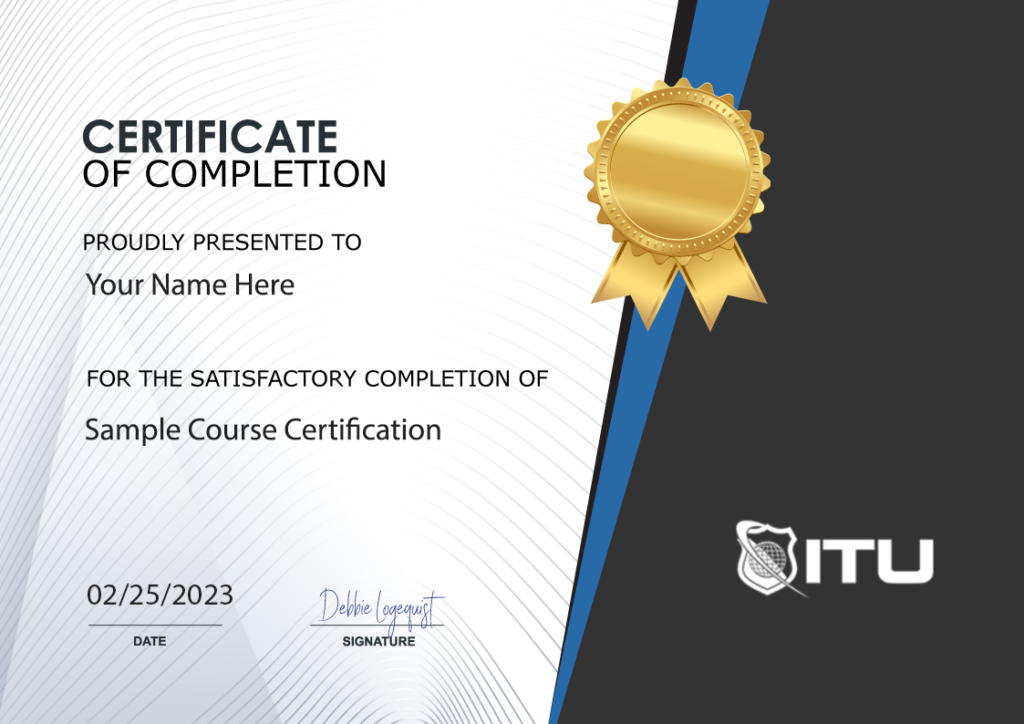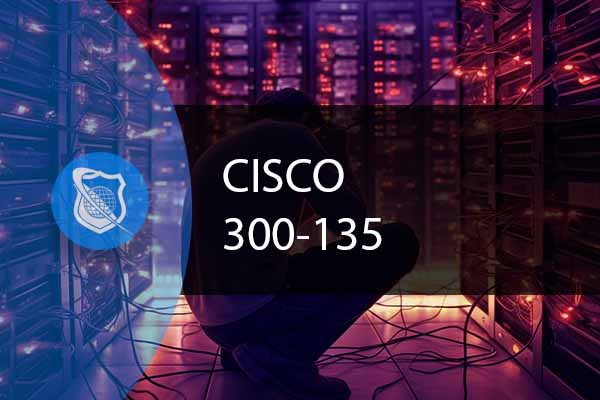Cisco CCNP Troubleshooting IP Networks 300-135
The CCNP Troubleshooting IP Networks 300-135 exam ascertains that the candidate possesses the information and abilities required to regularly maintain complex enterprise routed and switched networks.
Included In This Course



Closed Captions



Certificate of Completion
Course Description for Cisco Troubleshooting IP Networks 300-135
This course, “Cisco 300-135: CCNP – TSHOOT – Troubleshooting and Maintaining Cisco IP Networks,” is designed to provide network professionals with the skills and knowledge needed to troubleshoot and maintain Cisco IP networks effectively. It covers a comprehensive range of topics including troubleshooting techniques, IOS troubleshooting commands, remote data gathering, and graphical troubleshooting tools. Through this course, learners will gain practical experience and insights into managing and resolving network issues in real-world scenarios.
Participants will delve into the intricacies of troubleshooting switches, VLANs, trunking, spanning tree protocols, inter-VLAN routing, switch security features, and both IPv4 and IPv6 addressing. Additionally, the course covers advanced topics such as GRE tunnels, routing protocols (RIP, EIGRP, OSPF, BGP), policy-based routing, and management protocols. Each module is designed to build upon the previous one, ensuring a thorough understanding of the Cisco troubleshooting process.
What You Will Learn in Cisco Troubleshooting IP Networks 300-135
By completing this course, you will acquire essential skills and knowledge to efficiently troubleshoot and maintain Cisco IP networks. The course will enhance your ability to diagnose and resolve network issues, ensuring optimal network performance and reliability.
- Master IOS troubleshooting commands and remote data gathering techniques
- Gain proficiency in using graphical troubleshooting tools
- Understand and troubleshoot VLANs, trunking, and spanning tree protocols
- Learn to troubleshoot inter-VLAN routing and Layer 3 EtherChannel
- Address and resolve switch security issues
- Handle IPv4 and IPv6 addressing and related technologies
- Troubleshoot access control lists (ACLs) and prefix lists
- Manage and troubleshoot GRE tunnels and routing protocols such as RIPv2, RIPng, EIGRP, OSPF, and BGP
- Utilize management protocols and tools for effective network management
Exam Objectives for Cisco Troubleshooting IP Networks 300-135 Certification
The Cisco 300-135 exam, part of the CCNP certification, tests candidates on their ability to troubleshoot and maintain complex enterprise routed and switched networks. This certification is governed by Cisco Systems and is recognized globally as a standard for network troubleshooting expertise.
- Troubleshooting and Maintaining IP Networks: 30%
- Troubleshooting Switching Technologies: 20%
- Troubleshooting Routing Technologies: 20%
- Troubleshooting Security Technologies: 15%
- Troubleshooting Management and Operations: 15%
Who This Cisco Troubleshooting IP Networks 300-135 Course is For
This course is ideal for networking professionals looking to enhance their troubleshooting skills and achieve the CCNP certification. Whether you are a network engineer, technician, or administrator, this course will provide you with the knowledge and expertise to excel in your role.
- Network engineers and administrators
- IT professionals seeking CCNP certification
- Individuals responsible for maintaining enterprise networks
- Technical support engineers
- Anyone looking to advance their career in network troubleshooting
Possible Jobs You Can Get With This Knowledge in Cisco Troubleshooting IP Networks 300-135
With the skills and knowledge gained from this course, you will be well-equipped to pursue various job roles in the networking field. These roles are critical for maintaining the performance and reliability of enterprise networks.
- Network Engineer
- Network Administrator
- Technical Support Engineer
- Network Operations Center (NOC) Technician
- IT Support Specialist
- Systems Engineer
Average Industry Salaries for People with Cisco Troubleshooting Skills
Acquiring advanced troubleshooting skills in Cisco networks can significantly enhance your earning potential. Here are some average salary ranges for related job roles:
- Network Engineer: $70,000 – $100,000 per year
- Network Administrator: $60,000 – $85,000 per year
- Technical Support Engineer: $55,000 – $80,000 per year
- NOC Technician: $50,000 – $75,000 per year
- IT Support Specialist: $45,000 – $70,000 per year
Get Started Today with Cisco Troubleshooting IP Networks 300-135
Take the first step towards mastering network troubleshooting and achieving your CCNP certification. Enroll in the Cisco 300-135 course today and gain the expertise needed to tackle complex network issues with confidence. With comprehensive modules, practical insights, and expert guidance, this course will set you on the path to success in the networking field.
Don’t wait! Boost your career and become a Cisco network troubleshooting expert. Enroll now and start your journey towards professional excellence.
Key Term Knowledge Base: Key Terms Related to Cisco Troubleshooting IP Networks 300-135
Understanding the key terms associated with Cisco Troubleshooting IP Networks 300-135 is crucial for anyone preparing for this certification exam. Mastery of these concepts not only aids in passing the exam but also equips network professionals with the necessary skills to diagnose and resolve complex network issues efficiently. Below is a comprehensive list of essential terms that are integral to Cisco troubleshooting practices.
| Term | Definition |
|---|---|
| ACL (Access Control List) | A set of rules used to control network traffic and reduce network attacks. |
| ARP (Address Resolution Protocol) | A protocol used to map an IP address to a physical machine address. |
| BGP (Border Gateway Protocol) | A protocol designed to exchange routing information between different networks on the Internet. |
| CDP (Cisco Discovery Protocol) | A proprietary protocol used by Cisco devices to share information about other directly connected Cisco equipment. |
| EIGRP (Enhanced Interior Gateway Routing Protocol) | An advanced distance-vector routing protocol used on a computer network for automating routing decisions and configuration. |
| HSRP (Hot Standby Router Protocol) | A Cisco protocol that provides network redundancy for IP networks, ensuring that network traffic immediately and transparently recovers from first-hop router failures. |
| IOS (Internetwork Operating System) | The software used on a majority of Cisco Systems routers and network switches. |
| IP SLA (IP Service Level Agreement) | A feature that allows an IT professional to collect information about network performance in real time. |
| MPLS (Multiprotocol Label Switching) | A routing technique in telecommunications networks that directs data from one node to the next based on short path labels rather than long network addresses. |
| NAT (Network Address Translation) | A method used by routers to translate private (not globally unique) addresses into legal addresses before packets are forwarded to another network. |
| OSPF (Open Shortest Path First) | A link-state routing protocol used for Internet Protocol (IP) networks, which uses a link state routing (LSR) algorithm and falls into the group of interior gateway protocols (IGPs). |
| QoS (Quality of Service) | The description or measurement of the overall performance of a service, such as a telephony or computer network, particularly the performance seen by the users of the network. |
| SNMP (Simple Network Management Protocol) | An Internet-standard protocol for collecting and organizing information about managed devices on IP networks and for modifying that information to change device behavior. |
| SSH (Secure Shell) | A cryptographic network protocol for operating network services securely over an unsecured network. |
| STP (Spanning Tree Protocol) | A network protocol that builds a loop-free logical topology for Ethernet networks. |
| SYSLOG | A standard for message logging that is used for system management and security auditing. |
| TCP/IP (Transmission Control Protocol/Internet Protocol) | The suite of communications protocols used to connect hosts on the Internet. |
| TFTP (Trivial File Transfer Protocol) | A simple file transfer protocol that allows a client to get from or put a file onto a remote host. |
| VLAN (Virtual Local Area Network) | A group of devices on one or more LANs that are configured to communicate as if they were attached to the same wire, when in fact they are located on a number of different LAN segments. |
| VTP (VLAN Trunking Protocol) | A Cisco proprietary protocol that propagates the definition of Virtual Local Area Networks (VLAN) on the whole local area network. |
| Wireshark | A network protocol analyzer that enables users to capture and interactively browse the traffic running on a computer network. |
| Traceroute | A network diagnostic tool for displaying the route (path) and measuring transit delays of packets across an IP network. |
| Ping | A network utility used to test the reachability of a host on an Internet Protocol (IP) network. |
| NetFlow | A network protocol developed by Cisco for collecting IP traffic information and monitoring network traffic. |
| Syslog | A standard for message logging used to forward log messages in an IP network. |
| Wi-Fi Analyzer | A tool that provides information about the wireless environment, helping diagnose problems with Wi-Fi connectivity. |
| Traceroute | A command that shows the path a packet of data takes from one device to another across a network. |
| Packet Sniffer | A tool that captures and analyzes packets of data sent across a network. |
| Network Baseline | A standard against which the performance of a network can be compared or assessed. |
| Redundancy | The duplication of critical components or functions of a system with the intention of increasing reliability of the system, usually in the form of a backup or fail-safe. |
| Topology | The arrangement of various elements (links, nodes, etc.) of a computer network. |
| Routed Protocol | A protocol by which data can be routed. Examples include IP, IPX, and AppleTalk. |
| Routing Protocol | A protocol used by routers to exchange routing information with one another. Examples include BGP, OSPF, and EIGRP. |
| Subnet Mask | A 32-bit number that masks an IP address and divides the IP address into network address and host address. |
| TCP Window Size | A flow control mechanism to manage the amount of data that a sender can transmit before needing an acknowledgment. |
| VTP Pruning | A feature in VTP that reduces broadcast traffic by restricting the flooding of VLAN information to those trunk links that the VLANs are active on. |
By familiarizing yourself with these terms, you’ll be better prepared to tackle the challenges presented in the Cisco Troubleshooting IP Networks 300-135 exam, as well as in practical networking scenarios.
Frequently Asked Questions About Cisco CCNP Troubleshooting IP Networks 300-135
What is the Cisco 300-135: CCNP – TSHOOT course about?
The Cisco 300-135: CCNP – TSHOOT course is designed to provide network professionals with the skills and knowledge needed to troubleshoot and maintain Cisco IP networks effectively. It covers topics like troubleshooting techniques, IOS troubleshooting commands, remote data gathering, and graphical troubleshooting tools.
What are the main topics covered in the Cisco 300-135 course?
The course covers a wide range of topics including troubleshooting switches, VLANs, trunking, spanning tree protocols, inter-VLAN routing, switch security features, IPv4 and IPv6 addressing, access control lists (ACLs), GRE tunnels, routing protocols (RIP, EIGRP, OSPF, BGP), policy-based routing, and management protocols.
Who should take the Cisco 300-135: CCNP – TSHOOT course?
This course is ideal for networking professionals such as network engineers, administrators, technical support engineers, and IT professionals seeking CCNP certification. It is also beneficial for individuals responsible for maintaining enterprise networks.
What job roles can I pursue with Cisco troubleshooting skills?
With Cisco troubleshooting skills, you can pursue various job roles such as Network Engineer, Network Administrator, Technical Support Engineer, Network Operations Center (NOC) Technician, IT Support Specialist, and Systems Engineer.
What are the average industry salaries for professionals with Cisco troubleshooting skills?
Average industry salaries for professionals with Cisco troubleshooting skills are as follows: Network Engineer: $70,000 – $100,000 per year; Network Administrator: $60,000 – $85,000 per year; Technical Support Engineer: $55,000 – $80,000 per year; NOC Technician: $50,000 – $75,000 per year; IT Support Specialist: $45,000 – $70,000 per year.
Proudly DisplayYour Achievement
Upon completion of your training, you’ll receive a personalized certificate of completion to help validate to others your new skills.
Cisco 300-135: CCNP - TSHOOT - Troubleshooting and Maintaining Cisco IP Networks Course Content
Module 1: Introduction to Cisco Troubleshooting
- Introduction
- Troubleshooting And Maintenance
- IOS Troubleshooting Commands
- Remote Data Gathering
- Introduction To Graphical Troubleshooting Tools And Review
Module 2: Troubleshooting Switches
- Troubleshoot Catalyst Switches
- Troubleshoot TCAM
Module 3: Troubleshooting VLANS and Trunking
- Troubleshooting VLANs And Trunking-Part1
- Troubleshooting VLANs And Trunking-Part2
- Troubleshooting VLANs And Trunking-Part3
- Trouble Ticket 1 VLANS
Module 4: Troubleshooting Spanning Tree Protocol, EtherChannel
- Spanning Tree Protocol
- STP Port Configuration
- Ether Channel
- Trouble Ticket 2-Trunking
Module 5: Troubleshooting InterVLAN Routing and Layer 3 EtherChannel
- Troubleshooting Inter-VLAN Routing
- Troubleshooting Layer 3 Ether Channel
Module 6: Troubleshooting Switch Security Features
- Troubleshoot Switch Security-Part1
- Troubleshoot Switch Security-Part2
- Trouble Ticket 3-Switch Security-Part1
- Trouble Ticket 3-Switch Security-Part2
Module 7: Troubleshooting FirstHop Redundancy Protocols
- HSRP
- VRRP
- Questions
- Trouble Ticket 4
Module 8: Troubleshooting IPv4 and IPv4 Addressing
- IPv4 Addressing DHCPNAT-Part1
- IPv4 Addressing DHCPNAT-Part2
- Trouble Ticket 5
- Trouble Ticket 6
Module 9: IPv6 Addressing and Addressing Technologies
- IPv6 Addressing Options
Module 10: Troubleshooting IPv4 and IPv6 ACLs and Prefix Lists
- IPv4 ACLs
- Prefixlists IPv6 ACLs
- Trouble Ticket Access Control List1
- Trouble Ticket Access Control List2
Module 11: Troubleshooting GRE and Basic Routing Tunnels
- IPv4 Routing-Part1
- IPv4 Routing-Part2
- IPv6 Routing
- GRE Tunnels
Module 12: Troubleshooting RIPv2 and RIPng
- RIPv2
- RIPng
Module 13: Troubleshooting EIGRP
- EIGRP
- EIGRP For IPv6
- Trouble Ticket 1
- Trouble Ticket 2
Module 14: OSPF and OSPFv3
- OSPF-Part1
- OSPF-Part2
- OSPFv3
- Trouble Ticket 1
- Trouble Ticket 2
- Trouble Ticket 3
Module 15: Troubleshooting Route Maps and Policy Based Routing
- Route Maps And Policy Based Routing
Module 16: Troubleshooting Redistribution
- Verifying Redistribution Configuration
- Troubleshooting Redistribution With Route Maps
Module 17: Troubleshooting BGP
- BGP Overview
- BGP Configuration-Part1
- BGP Configuration-Part2
- Trouble Ticket 1
- Trouble Ticket 2
Module 18: Troubleshooting Management Protocols and Tools
- Troubleshooting Management Protocols And Tools
- SPAN And RSPAN
Module 19: Troubleshooting Management Access
- Management Access Troubleshooting
- Conclusion
| 5 star | 82 | 82% |
| 4 star | 17 | 17% |
| 3 star | 1 | 1% |
| 2 star | 0% | |
| 1 star | 0% |
Sorry, no reviews match your current selections
Your Training Instructor
Chrys Thorsen is an education and technology expert who specializes in enterprise-level IT infrastructure consulting and certified training-of-trainers. In her career, she has garnered over 50 IT Certifications including CISSP, CISA, CEHv12, PenTest+, CompTIA CNVP, Cisco CCSI/CCNP, Microsoft Cloud and on-premises technologies, VMware vSphere, and many more. She has also authored 40 published certification textbooks, and over 35 full-length IT certification video courses.
When not working in the United States, Chrys spends her time abroad capacity-building IT literacy in developing nations in Sub-Saharan Africa. Her client list has included: the US Federal Government, the Republic of Zambia Ministry of Health, Cavendish University Zambia, Accenture, JP Morgan Chase, the US Centers for Disease Control and Prevention, the Elizabeth Glaser Pediatric AIDS Foundation (EGPAF), Hughes Aircraft, Microsoft, and many more.
Chrys lives by, and is fond of repeating, her professional creed:
“The only true measure of success for any project or training is results on the ground. Everything else is just noise.” “I teach what I deploy; I deploy what I teach.”

Subscribe To All-Access
Lock In $16.99 / Month Forever
Access this course and over 3,000 hours of focused IT training. Start your first month for only $1.00. Then lock in only $16.99 / month for life.
- Get Every Course
- Free Updates / New Content Added
- 3,000+ Hours of Training
- Price Lock Guarantee
- Games / Flashcards
- 21,000+ Practice Questions
$49.99 $16.99 Monthly
$49.00




good
Smooth delivery and easy access to LMS. Good to see that the LMS offers progress tracking. Would be great if badges were offered on completion of courses to share via Credly to future employers.